- Faculty News
- Student News
- Lab News
- Publications
- Meetings and Presentations
- Outreach
- Grants
- Announcements
- About This Newsletter
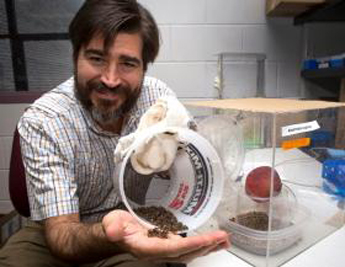
ABOVE: Dr. Daniel Hahn,was on the Academic minute on National Public Radio (NPR) last month talking about his "sexy" fruit flies.
Now we know why it was so hard to find a nematologist May 3rd to 9th. They were all in South Africa. The nematologists of South Africa hosted the 6th International Congress of Nematologists. There were over 500 in attendance, with nematologists coming from all parts of the world.
Those attending from Florida included faculty Dr. Don W. Dickson, Dr. William Crow, Dr. Larry Duncan, Dr. Joe Noling, Dr. Robin Giblin Davis, Dr. Janete Brito, Dr. Tesfa Mengistu, post doctorate Dr. Maria Mendes, and graduate students Silvia Vau, Kanan Kutsuwa, Tina Gu, and Richard Baidoo.

Dr. Jim Maruniak took the Society for Viral Studies (aka, Virology Club) to Lima, Peru, for the annual medically oriented trip. The eight students and Maruniak were in Peru from May 3rd to May 13th. They visited the Cayetano Heredia Hospital and the Universidad Peruana Cayetano Heredia medical school.
They watched physicians performing and viewing diagnostic microbiology tests early in the morning before going to visit their patients. Students observed doctors and medical students treating patients. They saw many different types of parasites in the parasitology laboratory, which also had preserved samples of poisonous spiders and Reduviidae, which are Chagas disease vectors.
At the medical school they attended lectures in Spanish about HIV and immunology. The medical students watch video lectures before coming to class (like distance education); then in class the medical professor, without PowerPoint presentations, asked questions to most of the students.
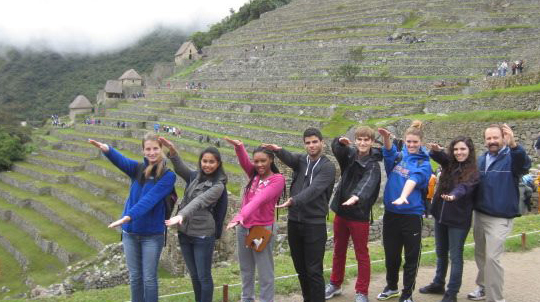
ABOVE: Their trip included taking a bus and train to Cusco and Machu Picchu. The Inca ruins are breath taking, especially the part where Dr. Maruniak had to follow the students up the Inca trail to 8,900 feet.

Dr. Phil Kaufman and a team of researchers visited numerous cities and agricultural facilities across China as a part of the USDA, Foreign Agriculture Service, Scientific Cooperative Exchange Program, which also was sponsored by the Chinese Ministry of Agriculture.
Team members included Drs. Jerry Hogsette (USDA-ARS-CMAVE, Gainesville, FL), Andrew Li (USDA-ARS-IIBBC, Beltsville, MD) and Ping Hu (Auburn University). During the visit, the team met with numerous colleagues from several Chinese universities, the China Centers for Disease Control and Prevention, animal disease control centers, the Sino American Biological Control Laboratory and dairy producers to discuss livestock pest management challenges in China and the potential to establish future collaborations. During the 14-day trip, the team traveled to the cities of Beijing, Hohhot (Inner Mongolia autonomous region), Shanghai and Haikou (Hainan province).
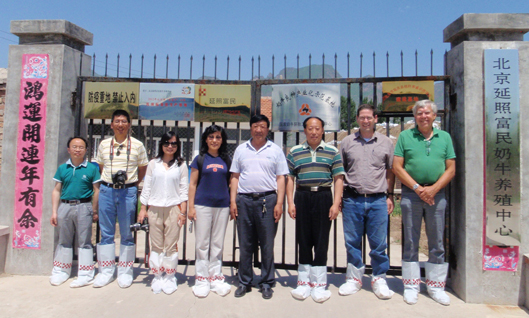
ABOVE: Dr. Andrew Li (2nd from left), Dr. Ping Hu (4th from left) and Dr. Phil Kaufman and Dr. Jerry Hogsette (far right) met with Dr. Baoliang Pan (far left) of the College of Veterinary Medicine at the Chinese Agricultural University-Beijing and management staff of the University's dairy research unit located north of Beijing, China. Also pictured is Ms. Hu Rong (3rd from right), Program Officer with the Ministry of Agriculture. Members who toured animal rearing facilities are wearing biosecurity plastic booties, one of several measures taken to protect the dairy cattle from outside pathogens.
 Dr. Christine W. Miller served as a keynote speaker for the 2014 Symposium in Ecology, Evolution, and Behavior at the University of Kentucky on May 15, 2014. The Center for Ecology, Evolution, and Behavior, which puts on the symposium, is a joint venture between the Entomology, Psychology, and Biology Departments at the University of Kentucky.
Dr. Christine W. Miller served as a keynote speaker for the 2014 Symposium in Ecology, Evolution, and Behavior at the University of Kentucky on May 15, 2014. The Center for Ecology, Evolution, and Behavior, which puts on the symposium, is a joint venture between the Entomology, Psychology, and Biology Departments at the University of Kentucky.
Dr. Christine Miller's photograph of the cactus bug, Chelinidea vittiger (Hemiptera: Coreidae) is featured on the June 2014 cover of the journal Ecology.
 Dr. Akito Kawahara and Nick Homziak traveled to French Guiana in May 2014 to study bat-moth interactions.
Dr. Akito Kawahara and Nick Homziak traveled to French Guiana in May 2014 to study bat-moth interactions.
 The UF/IFAS Brazilian peppertree biological control program was featured in the ESA’s Newsletter Entomology Today.
The UF/IFAS Brazilian peppertree biological control program was featured in the ESA’s Newsletter Entomology Today.
 A new Insect Photo Gallery CD-ROM titled “Beneficial Arthropods, Parasitoids” was recently completed and will be distributed to all UF/IFAS County Extension Offices. The purpose of the CD is to provide Extension faculty with high-quality images of common parasitoids and their hosts for use in their presentations and publications. This was a collaborative effort by departmental faculty/staff and current/former students.
A new Insect Photo Gallery CD-ROM titled “Beneficial Arthropods, Parasitoids” was recently completed and will be distributed to all UF/IFAS County Extension Offices. The purpose of the CD is to provide Extension faculty with high-quality images of common parasitoids and their hosts for use in their presentations and publications. This was a collaborative effort by departmental faculty/staff and current/former students.
Nematology students Silvia Vau and Tina Gu both won 2nd place in the Best Student Paper presentations at the 6th International Congress of Nematologists in South Africa. Congratulations to them for doing such a great job representing our program!
 Dr. Lacey Jenson (Ph.D. December, 2013, Dr. Jeff Bloomquist, major professor) was designated as one of three finalists for the Young Investigator Award by the Agrochemicals Division of the American Chemical Society (ACS). She will present her research at a symposium at the ACS national meeting in San Francisco this coming August, and part of the award is $1,000 to defray travel expenses. The award winner will be announced after the three finalist seminars are presented. Last year's winner of this award was Dr. Daniel Swale, who completed his doctorate with Dr. Bloomquist in December of 2012.
Dr. Lacey Jenson (Ph.D. December, 2013, Dr. Jeff Bloomquist, major professor) was designated as one of three finalists for the Young Investigator Award by the Agrochemicals Division of the American Chemical Society (ACS). She will present her research at a symposium at the ACS national meeting in San Francisco this coming August, and part of the award is $1,000 to defray travel expenses. The award winner will be announced after the three finalist seminars are presented. Last year's winner of this award was Dr. Daniel Swale, who completed his doctorate with Dr. Bloomquist in December of 2012.
 Lary Reeves traveled to Peru to work on Cyclosa dummy spiders, research being covered by BBC.
Lary Reeves traveled to Peru to work on Cyclosa dummy spiders, research being covered by BBC.
 Minjia Zhong (Bucholtz High School) received a Mu Theta Alpha grant to study saturniid moths in the Kawahara lab. $2,000; a huge accomplishment for a high school student.
Minjia Zhong (Bucholtz High School) received a Mu Theta Alpha grant to study saturniid moths in the Kawahara lab. $2,000; a huge accomplishment for a high school student.
 Ms. Julie Baniszewski, an undergraduate student in Dr. Jim Cuda’s lab, was the recipient of the ESA Plant-Insect Ecosystems Undergraduate Student Achievement in Entomology Award.
Ms. Julie Baniszewski, an undergraduate student in Dr. Jim Cuda’s lab, was the recipient of the ESA Plant-Insect Ecosystems Undergraduate Student Achievement in Entomology Award.
Ms. Gabrielle Nease joined the laboratory of Dr. James P. Cuda for the summer (and hopefully beyond). Gabby is a Horticultural Science Major and will be responsible for propagating and maintaining our nursery plants.
Need to name that bug? A host of experts are available to help Floridians identify any insect or related arthropod. If a mystery creature has six or more legs, the UF Insect ID Lab is the place to call.
The lab receives calls about “bird mite” and “rat mite” problems throughout the year. Most of these turn out to be “invisible itch” cases that do not involve bird mites, or any other insect or mite for that matter.
Several of the calls during May sounded like real mite problems, so we asked for samples of the mites that were biting people in their homes. The offending creatures in these cases were tropical fowl mites, Ornithonyssus bursa. Homeowners that are getting bitten by these mites are usually already aware of a bird nest somewhere on the structure. The mites live in the nest and take blood meals from the birds until the young birds are old enough to leave the nest. Left without a host, the mites wander from the nest and may then encounter and bite people.
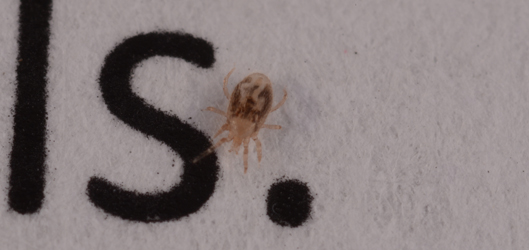
ABOVE: When bird and rat mites are biting people, the mites are usually not difficult to find. They are indeed tiny, and many folks describe them as the size of a period on a printed page (as seen above). They are easiest to spot when walking across a smooth, white surface. This photo is of a closely related species, the tropical rat mite (Ornithonyssus bacoti), which also can be found biting people in homes.
Lyle Buss is the Insect ID Lab manager.
 Think it might be a nematode problem? The Nematode Assay Laboratory serves Florida and other states by providing nematode assays and expert advice regarding nematode management.
Think it might be a nematode problem? The Nematode Assay Laboratory serves Florida and other states by providing nematode assays and expert advice regarding nematode management.
Since January 2014, the Nematode Assay Laboratory processed 1,400 extension and research samples.
For more information on the Nematode Assay Laboratory please contact the lab manager Dr. Tesfa Mengistu.
Burkett-Cadena ND, Bingham AM, Porterfield C, Unnasch TR. 2014. Innate preference or opportunism: Mosquitoes feeding on birds of prey at the Southeastern Raptor Center. Journal of Vector Ecology 39: 21-31.
Chen FY, Mekete T, Dababat AA, Daub M, Cao ZP, Sikora RA. 2014. Response of nematode communities to reclamation of agricultural soils following degradation through brown coal strip-mining processes. Helminthologia 5: 53-62.
Coy MR, Hoffmann M, Kingdom Gibbard HN, Kuhns EH, Pelz-Stelinski KS, Stelinski LL. 2014. Nested quantitative PCR approach with improved sensitivity for the detection of low titer levels of Candidatus Liberibacter asiaticus in the Asian citrus psyllid, Diaphorina citri Kuwayama. Journal of Microbiological Methods 102: 15-22.
GIGA Community of Scientists, Lopez J, Bracken-Grissom H, Collins A, Collins T, Crandall K, Distel D, Dunn C, Giribet G, Haddock S, Knowlton N, Martindale M, Medina M, Messing C, O'Brien S, Paulay G, Putnam N, Ravasi T, Rouse G, Ryan J, Schulze A, Wörheide G, Adamska M, Voolstra C, Bailley X, Breinholt JB, Evans N, Browne W, Diaz M, Fogarty N, Johnston M, Laberge T, Kawahara AY, Lavrov D, Michonneau F, Kamel B, Moroz L, Oakley T, Pomponi S, Rodriguez-Lanett M, Santos S, Satoh S, Thacker R, van der Peer Y, Winston J, Zhou X. 2014. The Global Invertebrate Genomics Alliance: Developing community resources to study diverse invertebrate genomes. Journal of Heredity 105: 1-18.
Hall HG, Ascher JS. 2014. The distinctive bee fauna (Hymenoptera: Apoidea: Anthophila) of sandhill habitat at the Ordway-Swisher Biological Station in north-central Florida. Journal of the Kansas Entomological Society 87: 1-21.
Lees DC, Kawahara AY, Rougerie R, Ohshima I, Kawakita A, Bouteleux O, DePrins J, Lopez-Vaamonde C. 2014. DNA barcoding reveals a largely unknown fauna of Gracillariidae leaf-mining moths in the Neotropics. Molecular Ecology Resources 14: 286-296.
Lee G-E, Hayden J, Kawahara AY. 2014. External egg morphology of the Hawaiian dancing moth, Dryadaula terpsichorella. Journal of Natural History 48: 969-974.
Martini X, Pelz-Stelinski KS, Stelinski LL. 2014. Plant pathogen-induced volatiles attract parasitoids to increase parasitism of an insect vector. Frontiers in Ecology and Evolotion. 2: 8.
O’Neil ST, Dzurisin JDK, Williams CM, Lobo NF, Higgins JK, Deines JM, Carmichael RD, Zeng E, Tan JC, Wu GC, Emrich SJ, Hellmann JJ. 2014. Gene expression in closely-related species mirrors local adaptation: Consequences for responses to a warming world. Molecular Ecology 23: 2686-2698.
Pombert JF, Blouin NA, Lane C, Boucias D, Keeling PJ. 2014. A lack of parasitic reduction in the obligate parasitic green alga Helicosporidium. PLOS Genomics 10: e1004355.
Teal PEA, Jones D, Jones G, Torto B, Nyasembe V, Borgemeister C, Alborn HT, Kaplan F, Boucias D, Lietze V-U. 2014. Identification of methyl farnesoate from the hemolymph of insects. Journal of Natural Products 77: 402-405. DOI: 10.1021/np400807v.
Toé LD, Koala L, Burkett-Cadena ND, Traoré BM, Sanfo M, Kambiré SR, Cupp EW, Traoré S, Yameogo L, Boakye D, Rodríguez-Pérez MA, Unnasch TR. 2014. Optimization of the Esperanza window trap for the collection of the African onchocerciasis vector Simulium damnosum sensu lato. Acta Tropica 137: 39-43.
Wu K, Hoy MA. 2014. Oral delivery of double-stranded RNA induces polonged and systemic gene knockdown in Metaseiulus occidentalis only after feeding on Tetranychus urticae. Experimental Applied Acarology 63: 171-187.
 New on Featured Creatures:
New on Featured Creatures:
hydrilla stem weevil, Bagous hydrillae O'Brien Authors: Emma Weeks, Jim Cuda, Entomology and Nematology Department, University of Florida, Michael J. Grodowitz, U.S. Army Engineer Research & Development Center
grass carp, Ctenopharyngodon idella Cuvier and Valenciennes Authors: Emma N.I. Weeks, Entomology and Nematology Department, University of Florida, Jeffrey E. Hill, Tropical Aquaculture Laboratory, Program in Fisheries and Aquatic Sciences, School of Forest Resources, University of Florida
convergent lady beetle, Hippodamia convergens Guérin-Méneville Authors: Luis F. Aristizábal and Steven P. Arthurs, Entomology and Nematology Department, University of Florida
Do you have a favorite creature? Learn how to make it into a Featured Creature!
The 7th Caribbean Beekeeping Congress and 2nd Annual Caribbean Bee College was May 26th to 30th, at the University of the Virgin Islands, Albert A. Sheen Campus, Kingshill, St. Croix, United States Virgin Islands. This full week of honey bee research, education, and current events featured leaders in apiculture from around the world. Dr. Jamie Ellis and Jeanette Klopchin of the HBREL, members of the Florida Apiary Inspection team and participants of the Florida Master Beekeeper Program served to organize the event and presented scientific papers as well as teach hands-on beekeeping workshops. The event attracted about 100 participants from the Caribbean and neighboring countries.
 Dr. Christine W. Miller attended the SCALE UP workshop held at the UF College of Education on May 13th. This workshop was presented by Robert Beichner, Distinguished Professor of Physics at North Carolina State University, to provide tools for faculty to move away from traditional lecture-style courses and more towards creating active learning environments in the classroom.
Dr. Christine W. Miller attended the SCALE UP workshop held at the UF College of Education on May 13th. This workshop was presented by Robert Beichner, Distinguished Professor of Physics at North Carolina State University, to provide tools for faculty to move away from traditional lecture-style courses and more towards creating active learning environments in the classroom.
 Dr. James P. Cuda was an invited speaker and author for the 2014 Aquatic Weed Control Shortcourse held in Coral Springs, Florida, 5-8 May. Cuda was a moderator for one of the Biological Sessions and gave a presentation titled “Combining different control tactics to reduce hydrilla biomass.” The presentation was co-authored by Dr. Jennifer Gillett-Kaufman, Dr. William Overholt, Dr. Emma Weeks, Dr. Verena Lietze, and Ph.D. candidate Mr. Eutychus Kariuki.
Dr. James P. Cuda was an invited speaker and author for the 2014 Aquatic Weed Control Shortcourse held in Coral Springs, Florida, 5-8 May. Cuda was a moderator for one of the Biological Sessions and gave a presentation titled “Combining different control tactics to reduce hydrilla biomass.” The presentation was co-authored by Dr. Jennifer Gillett-Kaufman, Dr. William Overholt, Dr. Emma Weeks, Dr. Verena Lietze, and Ph.D. candidate Mr. Eutychus Kariuki.
 Presentations at the International Nematology Congress in South Africa
Presentations at the International Nematology Congress in South Africa
Abebe E, Mekete T. Nematode types: Used or archived?
Joseph S, Martins L, Schmidt L, Hewlett T, Watrin C, Mekete T. Creation of Pasteuria penetrans clonal lines for study of genetic variation in Pasteuria spp. populations relating to host virulence
Seid A, Wesemael WML, Decraemer W, Mekete T, Fininsa C. Biodiversity of root-knot nematodes (Meloidogyne spp.) from major tomato growing areas of Ethiopia.
From the Outreach Coordinator
The live critters are always a hit with children and adults alike. The critters are available for you to check out should you be leading an outreach event. We have doubles of our most popular critters, as well as various native insect species depending on the time of year. We have large wood and Plexiglas cages for viewing our native orb weaving spiders. There is one travel cage and one larger static cage. Please be sure to contact us and review the protocol on transporting and handling the critters if you are not already familiar with it. If you lead an outreach, be sure to fill out a documentation form so your event can be included in the newsletter and we can log all outreach events.
If you would like to schedule an event or have any outreach questions, go to the Outreach pages on our Bug Club Website and contact us.
- Stephanie Stocks, Outreach Coordinator
- Office number 352-273-3958
 Getting social!
Getting social!
We have several social media sites for the Entomology & Nematology Department. To make them easily searchable, all three (YouTube, Facebook and Twitter) have the same page name: UFEntomology. Please share these links with past students or colleagues who may have an interest in departmental activities.
 BugWeek@UF 2014
BugWeek@UF 2014
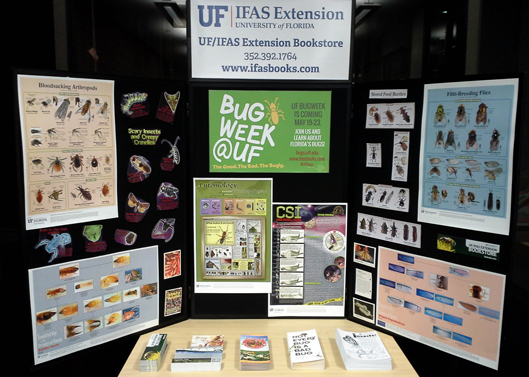
ABOVE: The UF Library system worked with the IFAS Bookstore to promote BugWeek@UF. In addition to this display in the Marston Science Library the library staff developed this very helpful Entomology Resource Guide we think you should all bookmark!
Virni Mattson, our grants specialist, reports that we have so many grants to process this month that we will report our May external funding for all Entomology & Nematology faculty (in Gainesville and at RECs) next month!
Two workshops that focus on identification of pest and beneficial insects and mites will be offered at GCREC in late June.
June 24: Invasive Pest Workshop, 8 AM-12:30 PM. Learn about European pepper moth, Bagrada bug and Kudzu bug, invasive pests of concern to the region. Taught by specialists from the University of Arizona, University of Georgia, and University of Florida.
June 26: Pest and Beneficial Insect Workshop, 8 AM-2 PM. Learn to identify whiteflies, thrips, mites, aphids, scales and mealybugs affecting ornamental and vegetable crops.
For more information, visit the links above or call Dr. Hugh Smith: 813-633-4124
 You might have seen the newest print version of the McGuire Center’s News. It is now available online at: http://www.flmnh.ufl.edu/mcguire/mcguireNews.htm
You might have seen the newest print version of the McGuire Center’s News. It is now available online at: http://www.flmnh.ufl.edu/mcguire/mcguireNews.htm
The McGuire Center also uploaded a separate (easier to read on the screen) publications list for the past year: http://www.flmnh.ufl.edu/mcguire/publications2013-2014.htm
 97th Annual Meeting of the Florida Entomological Society
97th Annual Meeting of the Florida Entomological Society
August 3rd to the 6th, 2014, at the Jupiter Beach Resort and Spa in Jupiter, Florida.
Pre-registration deadline for the meeting is Friday, June 18th. Payment may be made at the meeting, but the pre-registration form must be submitted no later than the deadline to get the discount. Registration forms can be found on the website under the Annual Meeting tab.
FES Honors and Awards 2014
The FES Honors and Awards Committee is requesting nominations for 2014 in the following categories:
Entomologist of the Year
Annual Achievement Award for Research
Annual Achievement Award for Extension
Annual Achievement Award for Industry
Annual Achievement Award for Teaching
Annual Achievement Award for Regulatory Entomology
Achievement Award for a Collaborative Research Team
Any other special awards
Winners will be announced at the 2014 Annual Meeting. Each nomination should be accompanied with a justification narrative that will be read at the awards luncheon.
Nomination deadline is July 1, 2014. Look at some of our previous winners.
Nominations should be sent to:
Jawwad Qureshi, Ph.D.
University of Florida, IFAS
Southwest Florida Research and Education Center
2685 SR 29 N
Immokalee, FL 34142-9515 USA
Ph: 239-658-3451
Fax: 239-658-3469
jawwadq@ufl.edu
We like to share news when it happens using our social media outlets: Twitter, Facebook and YouTube. Follow us on these sites for daily updates! When you send news, we will post it on one or more of these sites and again in the monthly newsletter. Please be sure you have permission from people in photographs you submit for publication.
UF-Bugnews-L listserv subscribers receive notices when issues are posted. Our home page has instructions for subscribing and unsubscribing.
Special thanks to Dr. Verena Lietze and Nancy Sanders, who reviewed the newsletter for errors, and to Jane Medley and Don Wasik, who built the web page design.